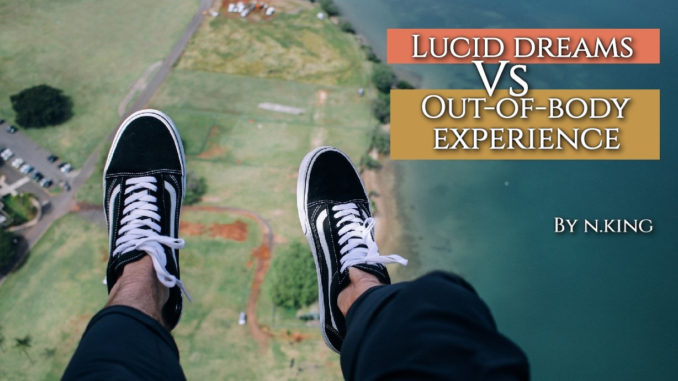
Many people dream of flying through open space. It’s no wonder people often choose to fly when they become self-aware in a dream. This is the experience of flight in a lucid dream. However, is this the same as an out-of-body experience (OBE)? What are the differences between OBE and lucid dreams?
During states of OBE , people describe it as a soul leaving the body and often claim, ” I saw myself sleeping.”Throughout history, there have been reports of people experiencing a levitation or floating out from their bodies. In response, many scientific studies have explored both states of inner awareness. Here are the 6 main differences between OBE and lucid dreams:

1. The Origins:
One of the main differences between OBE and lucid dreams is the origins. According to sleep lab studies, lucid dreams begin from within the dream state. From here, one recognizes that one is dreaming from within the dream.
In contrast, OBEs appear to originate from a place between the dream and waking world. Based on OBE reports, OBEs seem to commonly occur during moments of extreme trauma, illness, near death experiences, or use of certain drugs. In such cases, people described the ability to detach themselves from an experience.
As a lucid dreamer, I have not experienced OBEs as described in these reports.
2. The Sensations:
From OBE reports, many people claim to experience buzzing energetic vibrations before an out-of-body experience occurs. In contrast, there are few reports of energetic vibrations preceding lucid dreams.
In my personal experience as a lucid dreamer, I fall under the few who have experienced buzzing sensations before a lucid dream. However, it seems to occur in a deep transition moment between waking and dreaming. In this moment, the buzzing sensation subsides, my body feels lighter and I then drift into a lucid dream.
Interestingly, the Lucidity Institute – founded by Stephen LaBerge – discovered a strong correlation between lucid dreaming and OBEs.
LaBerge , a lucid dream expert , reported that out of 452 lucid dreamers, about 39% reported the experience of OBEs.
Therefore, a link appears to exist between lucid dreaming and OBEs. Perhaps one can induce the other?

3. The Ability to Change the Environment:
In lucid dreams, the dreamer holds the ability to change the environment through intent. Some examples of this includes shrinking objects, changing the colors or making something disappear in a dream.
In contrast, many OBE reports claim that one cannot change the environment through an out of body experience. Many describe the experience as feeling a separation from their body. In this moment, they often recall seeing their body below. Therefore, it appears that OBEs are generally experienced in the physical world.
On the other hand, lucid dreams seem to solely take place within a dream.
Interestingly, U.S. and Russian Intelligence agencies spent over 20 years exploring this way of projecting awareness out into the world to obtain classified info. This projection of awareness through a physical distance is called remote viewing.
Since lucid dreaming and OBEs appear to share a link – an overlap seems to appear. Some OBE reports describe the physical surroundings as a little different to reality. As an example, some recall seeing extra windows in their room or a different color ceiling. In such cases, some dream theorists explain this with the concept of parallel universes.
The theory of parallel universes holds that every possible outcome in life branches out into its own reality that exists as a parallel universe. Therefore, it is theorized that an OBE may journey into these parallel universes.
This type of OBE may involve drifting into an alternative reality where the walls of the bedroom could have been a different color from the color it is now.
In my personal experience, the closest I have come to experiencing an OBE is through dreaming of an OBE. In fact, according to Stephen LaBerge, just because it feels like you are leaving your body, it does not necessarily mean it is an OBE.
For example, he states that during deeper states of sleep, the body may feel weightless as the sensory input for gravity is shut off. Therefore, the mind may explain this weightlessness as an upward force. As a result, this may lead to the sensation of an out of body experience.

4. The Waking State:
How the waking state occurs is another big difference between OBE and lucid dreams.
According to reports, those who experience OBE describe a feeling of return to their bodies.
After this, they wake from the experience.
In contrast, many lucid dreamers describe waking up after the dream has blurred or blanked out. Other lucid dreamers describe waking up in the middle of a dream – usually by an alarm or other disruption.
In my personal experience, I have experienced the sensation of return to my body after a lucid dream. Once again, this makes one wonder about the link between lucid dreams and OBEs.

5. The Recall:
One of the big differences between OBE and lucid dreams is the detail of recall.
According to reports, OBEs appear easier to recall. The descriptions of OBEs are often clear, easily remembered and follow a linear order. Furthermore, the surrounding environment of OBEs closely match physical reality.
On the other hand, reports reveal that many lucid dreamers seem to recall the dream with less detail with no linear order. Additionally, the dream scene is not an accurate representation of the physical world.
In my personal experience, some of my lucid dreams are incredibly detailed. In fact, over time, some of my lucid dream flow in a linear order. As an example, I have experienced a long lucid dream of visiting a loved one and in the dream, we conversed in a very consistent and linear manner. However, the environment in the dream was very different from reality.
From this , one begins to question the correlation between lucid dreams and OBEs. Over time, could lucid dreaming serve as practice for OBEs? Is it possible for one to flow into the other?
Interestingly enough, the Dalai Lama, stated that lucid dreaming is great practice for the transition from this life to the next.
6. The Physiological Differences:
According to a book written by David Jay Brown, entitled “dreaming wide awake”, there is neuroscientific evidence that finds measurable physiological differences between OBEs and lucid dreams.
A study done in 1984 , by Australian psychologist Harvey Irwin, revealed that the brain wave patterns are different between OBE and lucid dreams.
For example, during states of OBEs, the brain wave patterns reflected alpha wave activity but hardly any REM (rapid eye movement). In contrast, lucid dreaming occurs during REM – the dream state of sleep. Therefore, this suggests that the events that followed in an OBE were not that of dreaming.

Final Thoughts on the Big Differences between OBE and Lucid Dreams
The mind is a mysterious portal of adventure, lessons and power. Whether we hallucinate, experience deeper states of being or visit different worlds – it is up to you to explore with an open mind. Everyone experiences OBEs , lucid dreams and other states of awareness differently. What matters is that you keep searching for answers.
– By Nikita King
